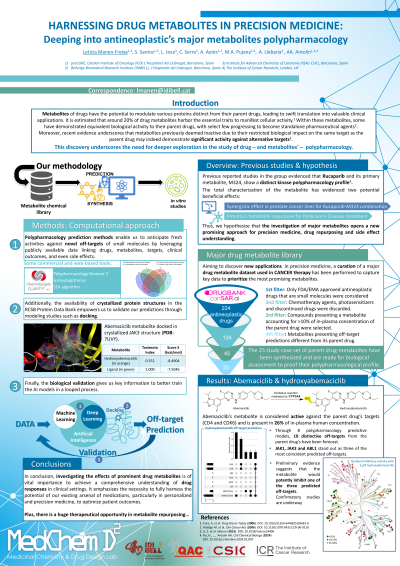Shaping the Future of Therapeutics
Poster Session A
(1006-A) HARNESSING DRUG METABOLITES IN PRECISION MEDICINE: Deeping into antineoplastic’s major metabolites polypharmacology
Tuesday, May 28, 2024
16:30 - 17:15 CEST
Location: Exhibit Hall

.jpg)
Leticia Manen-Freixa (she/her/hers)
R&D Scientist in Cheminformatics & Drug Design
IDIBELL (Bellvitge Institute of Biomedical Research)
Barcelona, Catalonia, Spain
Tony B. Poster Author(s)
Abstract:
The exploration of polypharmacology in drug metabolites is a seldom-addressed aspect in drug discovery and development. Despite this, certain drug metabolites can attain significant concentrations in the bloodstream and exhibit distinct in vivo activities compared to their parent drugs.
In pursuit of uncovering novel applications in precision medicine, we have curated a substantial dataset of major drug metabolites. Departing from the 224 FDA-approved until date antineoplastic drugs, we obtained a curated chemical library of 25 study cases where their metabolites accounted for more than 10% in-plasma concentration and showed a differential off-target profile from their parent drug as predicted via different computational methods (e.g., similarity-based methods, machine learning and deep learning models). After capturing crucial information of each case, the most promising case studies were prioritised in terms of synthetical feasibility (for both parent drug and major metabolite) and biological testing accessibility. Rucaparib served as the first successful case study of the group confirming our hypothesis1.
Another of these preliminary studies consist in the study of abemaciclib’s major metabolite, hydroxyabemaciclib. Abemaciclib is the only CDK4/6 inhibitor until date that is effective as a single agent in HR+ HER2-metastatic breast cancer2,3. Our computational methods predicted four off-targets of hydroxyabemaciclib that would not be inhibited by the parent drug. Among them, we were able to experimentally confirm JAK3 with an IC50 < 1 uM. Further validation is ongoing. These confirmed kinase activities of the metabolite may have noteworthy implications for the efficacy and safety of abemaciclib, warranting a further clinical exploration of this metabolite.
This study underscores the vital importance of thoroughly investigating the actions of major drug metabolites to achieve a comprehensive understanding of drug responses in clinical settings. It emphasizes the necessity to fully harness the potential of our existing arsenal of drugs, particularly in the context of personalized and precision medicine.
References
(1) Hu, H., Serra, C., Zhang, W., Scrivo, A., Fernández-Carasa, I., Consiglio, A., Aytes, A., Pujana, M. A., Llebaria, A., & Antolin, A. A. (2024). Identification of differential biological activity and synergy between the PARP inhibitor rucaparib and its major metabolite. Cell Chemical Biology. https://doi.org/10.1016/j.chembiol.2024.01.007
(2) George, M. A., Qureshi, S., Omene, C., Toppmeyer, D. L., & Ganesan, S. (2021). Clinical and Pharmacologic Differences of CDK4/6 Inhibitors in Breast Cancer. Frontiers in Oncology, 11. https://doi.org/10.3389/fonc.2021.693104
(3) Hafner, M., Mills, C. E., Subramanian, K., Chen, C., Chung, M., Boswell, S. A., Everley, R. A., Liu, C., Walmsley, C. S., Juric, D., & Sorger, P. K. (2019). Multiomics Profiling Establishes the Polypharmacology of FDA-Approved CDK4/6 Inhibitors and the Potential for Differential Clinical Activity. Cell Chemical Biology, 26(8), 1067-1080.e8. https://doi.org/10.1016/j.chembiol.2019.05.005
The exploration of polypharmacology in drug metabolites is a seldom-addressed aspect in drug discovery and development. Despite this, certain drug metabolites can attain significant concentrations in the bloodstream and exhibit distinct in vivo activities compared to their parent drugs.
In pursuit of uncovering novel applications in precision medicine, we have curated a substantial dataset of major drug metabolites. Departing from the 224 FDA-approved until date antineoplastic drugs, we obtained a curated chemical library of 25 study cases where their metabolites accounted for more than 10% in-plasma concentration and showed a differential off-target profile from their parent drug as predicted via different computational methods (e.g., similarity-based methods, machine learning and deep learning models). After capturing crucial information of each case, the most promising case studies were prioritised in terms of synthetical feasibility (for both parent drug and major metabolite) and biological testing accessibility. Rucaparib served as the first successful case study of the group confirming our hypothesis1.
Another of these preliminary studies consist in the study of abemaciclib’s major metabolite, hydroxyabemaciclib. Abemaciclib is the only CDK4/6 inhibitor until date that is effective as a single agent in HR+ HER2-metastatic breast cancer2,3. Our computational methods predicted four off-targets of hydroxyabemaciclib that would not be inhibited by the parent drug. Among them, we were able to experimentally confirm JAK3 with an IC50 < 1 uM. Further validation is ongoing. These confirmed kinase activities of the metabolite may have noteworthy implications for the efficacy and safety of abemaciclib, warranting a further clinical exploration of this metabolite.
This study underscores the vital importance of thoroughly investigating the actions of major drug metabolites to achieve a comprehensive understanding of drug responses in clinical settings. It emphasizes the necessity to fully harness the potential of our existing arsenal of drugs, particularly in the context of personalized and precision medicine.
References
(1) Hu, H., Serra, C., Zhang, W., Scrivo, A., Fernández-Carasa, I., Consiglio, A., Aytes, A., Pujana, M. A., Llebaria, A., & Antolin, A. A. (2024). Identification of differential biological activity and synergy between the PARP inhibitor rucaparib and its major metabolite. Cell Chemical Biology. https://doi.org/10.1016/j.chembiol.2024.01.007
(2) George, M. A., Qureshi, S., Omene, C., Toppmeyer, D. L., & Ganesan, S. (2021). Clinical and Pharmacologic Differences of CDK4/6 Inhibitors in Breast Cancer. Frontiers in Oncology, 11. https://doi.org/10.3389/fonc.2021.693104
(3) Hafner, M., Mills, C. E., Subramanian, K., Chen, C., Chung, M., Boswell, S. A., Everley, R. A., Liu, C., Walmsley, C. S., Juric, D., & Sorger, P. K. (2019). Multiomics Profiling Establishes the Polypharmacology of FDA-Approved CDK4/6 Inhibitors and the Potential for Differential Clinical Activity. Cell Chemical Biology, 26(8), 1067-1080.e8. https://doi.org/10.1016/j.chembiol.2019.05.005
